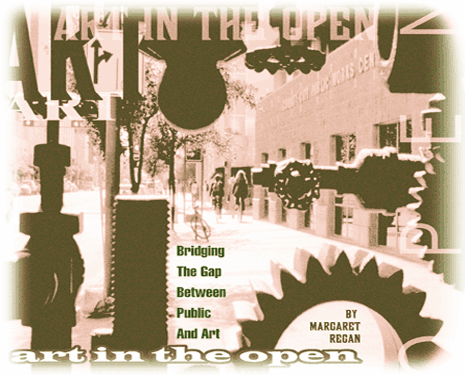
The Pleasures And Perils Of Public Creativity.
THERE ONCE WAS a Tucson photographer who spent his working
life recording the faces of the city's ordinary folks. From the late '30s to the early '60s, when just about every Tucsonan routinely traveled to the city's heart, the street photographer would prowl the busy sidewalks of Congress Street. "The guy hung out near the State Theatre at night," says artist Steve Farley.
 The photographer, whose name so far has eluded researchers like
Farley, had an MO that went like this. He would surreptitiously
snap overburdened moms and loping young men, sauntering teenage
girls and the elegant elderly. Then this paparazo del pueblo would
approach his quarry.
The photographer, whose name so far has eluded researchers like
Farley, had an MO that went like this. He would surreptitiously
snap overburdened moms and loping young men, sauntering teenage
girls and the elegant elderly. Then this paparazo del pueblo would
approach his quarry.
"Here's a card," he would say. "Come down to Ted
Litt if you want a picture of yourself."
Ted Litt, as everybody knew, was the drug store at Congress and
Stone. The accidental models could stop by the drug store later
and buy a little piece of immortality for 50 cents, in black and
white, on a picture postcard.
Next May, the people pictured on the cards will get an even bigger
shot at immortality. In one of the biggest public art projects
ever approved in Tucson--with a budget of $170,000--artist Farley
will install gigantic photographic tiles on the walls of the bleak
new Broadway underpass just east of downtown. Fourteen Tucsonans
photographed in those long-ago days will have their images writ
larger than life on the underpass wall, their fading photos translated
into crisp black and white and gray on ceramic.
"There are enough monuments to famous people in Tucson,"
says Farley, a graphic designer who has never before won a public
art commission.
Farley's realistic photographic images, distinct in a public
art climate that's heavy on metal, colored tiles, pop-art and
ethnic symbolism, have won the enthusiastic support of everybody
from politicians like City Manager Luis Gutierrez to art types
like gallery owner Terry Etherton. Most gleeful of all are the
ordinary citizens who sent in 197 of the old street photos in
response to Farley's call. Among the portraits were a shot of
the young David Fitzsimmons, editorial cartoonist of The Arizona
Daily Star, tootling along in a stroller, and Lalo Guerrero,
a Barrio Viejo native son who become a leading Latin musician
of Hollywood. Guerrero was photographed as an up-and-coming young
man striding purposefully along the street. He made the final
cut; Baby Fitz did not.
"People are so happy they were being honored for who they
were," says Farley, who did a dog-and-pony show of his proposal
to 17 different community groups. "The seniors were overwhelmed.
They said, 'It's so exciting! So great!' "
Farley's design is unusual because it literally puts the public
into public art, but it's in tune with the times, when public
art is no longer a marble hero in the public square. Nowadays,
public art is conceived democratically: it's constructed by an
artist, to be sure, but it's art of and for the people.
"The public is getting a collection of works of art that
they own," says Barbara Grygutis, a Tucson artist who has
won public art commissions all around the country. "They
can see it without going to a museum."
Public art ideally makes the visual life of a city more interesting,
delivering an aesthetic antidote to commerce, creating public
spaces in an age when the public square is vanishing. Traditional
murals celebrating ethnic heritage, like David Tineo's paintings
at the El Rio Neighborhood Center, balance out the consumerist
messages of squalid strip malls. Handmade terra cotta tiles on
a bus depot of re-used brick, such as Melody Peters' at the Ronstadt
Transit Center, counteract buildings of inhuman scale. All by
itself, it can hardly make up for the strident ugliness of our
fast-food joints, but public art stands for the hand-made against
the machine-made, for community against alienation.
"There's a lot of anonymity and standardization in cities,"
says Chris Tanz, an artist who deliberately tries to create a
sense of place in her environmental installations. "Public
art is the antithesis of all that. There's something personal
about it. The artist communicates with people. Public art is a
sub-category of 'special places,' and special places give me enormous
pleasure."
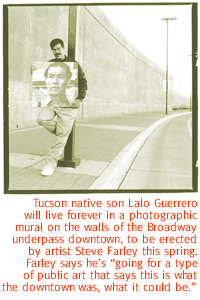 Tanz's large astronomical installation along the Rillito River
Park, "Sun Circle," a collaboration with Paul T. Edwards
and Susan Holman, is a Stonehengey affair whose stone walls are
carefully synchronized to the changes in light during the equinoxes
and solstices. It gives the artist no end of pleasure to find
the remains of burned candles in its plaza, remnants of mysterious
populist rituals related to the heavens.
Tanz's large astronomical installation along the Rillito River
Park, "Sun Circle," a collaboration with Paul T. Edwards
and Susan Holman, is a Stonehengey affair whose stone walls are
carefully synchronized to the changes in light during the equinoxes
and solstices. It gives the artist no end of pleasure to find
the remains of burned candles in its plaza, remnants of mysterious
populist rituals related to the heavens.
"I always find dripping bits of wax: it's nice to know that
something is being used for ceremonies that people have."
There was even, she says, a story in the paper about a "croning
ceremony" in the circle. Glimpsing past the women welcoming
old age, "I could see the walls in the photograph."
In the last 10 years, the proud crones and other taxpayers of
Tucson and Pima County have invested over $2 million in their
public art collection, $2,062,390 to be exact, paying for about
75 works of art. The University of Arizona has its own active
program--Grygutis this fall installed a large environmental piece
outside the theatre and art museum. Likewise, Tucson International
Airport acquires and commissions art; Grygutis and Tanz/Edwards
both constructed long barriers emblazoned with art there, Grygutis
with tools inside a green screen, Tanz and Edwards with metallic
mountains and clouds. The Tucson Museum of Art runs its own program,
with its most visible work the popular chicanismo mural on the
north facade by David Tineo and Antonio Pazos.
The Federal Government has a program too, inspired by the worthwhile
make-work arts programs of the Depression. Right now in Tucson,
the feds are underwriting a little bit of art payback that may
or may not compensate for the hulking courthouse they're constructing
on Granada Avenue. Jim Waid is making the biggest painting of
his life for the interior (see Tucson Weekly, July 28,
1998) and noted California artist Lita Albuquerque is a crafting
a sculpture garden for the courtyard. Both are scheduled to be
installed next summer.
But the bulk of the outdoor artwork making its appearance in
the last decade has come about through the city and county's one-percent-for-art
programs. Both governments have policies that require one percent
of the construction budget for new municipal improvements or buildings
to be devoted to art, or at least to artistic "enhancements.
"
WHAT HAS the public gotten for its money?
"Sonora," David Black's much-maligned lipstick-red
sculpture in front of the main library downtown, has remained
the whipping boy of Tucson's growing collection, while Susan Gamble's
beloved colored ceramic tiles installed in sculptural forms along
the west bank of the Santa Cruz may be its jewel in the crown.
Roger Asay's well-used bicycle paths along Mountain Avenue, art-ed
up with stone spirals and boulders, are part of the collection,
and so are the fleet of fanciful bus stops that recently sprouted
around downtown, notably Laura Slenning's antic car-cum-shelter
on Broadway at Fourth Avenue.
Tucsonans can expect to see a lot more in the next few years.
Just east of Farley's photographic installation, Simon Donovan's
gigantic snake bridge will rise over Broadway by early next summer.
Pedestrians and bicyclists will move through the belly of the
snake, high above the whizzing cars below, and peer out through
its porous patterned screen at the Tucson skyline.
A grandly conceived Gateway to Tucson will go up at downtown's
melancholy western edge, on a weedy lot just west of the I-10
exit ramp at Congress, lately home to the Desert Inn. A team of
Rancho Linda Vista artists and architect Bob Vint are imagining
an "art park" of walkways, with plantings by landscape
architects Liba Wheat and Eric Scharf, punctuated by huge "Monoliths."
These white forms, mildly evoking Spanish arches, will be big
enough to be seen from the freeway, while tiny artifacts encrusted
in their sides will entertain passers-by on foot.
At the low-key end, the bonds unleashed in last year's spring
elections will flood the county with new art "enhancements,"
projects along new and widened roads all over the county. Just
last week, seven artists got the nod to begin designing art for
roads from Sunrise Drive to Ajo Way.
The deluge of new bond money caused some grousing among the county
supervisors last March, when the art policy was up for renewal.
The bond packages together total close to $800 million, to be
disbursed over a dozen years or so. Some budget categories were
already excluded from the art obligation, but uneasy politicians
balked at spending a windfall of $8 million on art.
"Chuck Huckleberry proposed exempting several (new) categories
in the budget from art," says David Hoyt Johnson, director
of the public art program for the Tucson Pima Arts Council, which
administers the percent for art programs. "And he proposed
that art-based youth programs be funded from a public art set-aside."
Johnson is keenly aware of TPAC's "delicate role--we have
to maintain a good relationship with the government entities and
advocate on the artists' behalf and the citizens," and he
and his boss, Dian Magie, TPAC's executive director, were not
about to argue against kids' art programs. So they agreed to absolving
certain departments from art, and to giving up 10 percent of the
1 percent art set-aside to the kids, in exchange for a counterproposal
of their own. They asked that an artist be put on every design
committee for environmental and waste management projects. Critics
ridiculed the notion that the county should put "an artist
in every duck pond."
"We just asked that there be an artist on the team with
the engineer or hydrologist," Johnson says. Under the "team
concept," artists are brought in early in the design stages,
instead of being hauled in at the last moment and asked to fix
some clunky structure with pretty art. It's hard to argue with
Tucson's patently ugly infrastructure, and TPAC's idea prevailed.
It's the kind of compromise that happens all the time in public
art. Almost by definition, the coupling of "public"
and "art" does not a happy marriage make. Tiny though
the art budgets are--and most artists argue that the fees are
hardly making anyone rich--anti-tax types deplore even chump change
going to make the city look better.
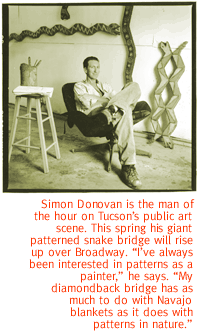 The big-bucks projects get the most attention, but those are
few and far between. Of the 75 projects in the last 10 years,
10 cost $5,000 or less, 11 came in between $5,000 ans $10,000,
12 between $10,000 and $15,000. Sometimes the artists make virtually
no money. For her Santa Cruz tiles, a $15,000 project, Gamble
says, "We broke even. I took no pay. I paid the others and
I paid for the materials." There was no money for anything
else.
The big-bucks projects get the most attention, but those are
few and far between. Of the 75 projects in the last 10 years,
10 cost $5,000 or less, 11 came in between $5,000 ans $10,000,
12 between $10,000 and $15,000. Sometimes the artists make virtually
no money. For her Santa Cruz tiles, a $15,000 project, Gamble
says, "We broke even. I took no pay. I paid the others and
I paid for the materials." There was no money for anything
else.
Bob Vint, the architect working on the Congress Street Gateway,
remembers that when he made the big ceramic lizard clinging to
Irvington Road a few years ago, $7 million went to the road, while
$50,000 went for the fanciful lizard. Yet it was the lizard's
cost that roused people's ire.
"To us, roads are really really important. We spend millions
on them, and we pay a fraction for the art. Then everybody complains
about the money wasted on art. No one ever says about a road,
Oh, what a waste of money.'"
Even the art park, with the highest-ever public art budget in
the program, is a bargain at $250,000. The gateway park has a
big job: it's supposed to transform the entrance to Tucson's downtown,
welcome visitors to the city, and signal its interesting cultural
mix. Yet "we're doing it for about half the cost of a typical
foothills house," Vint says. "The art park is on leftover
land by the highway, if you want to look at it cynically."
THE ART itself can be even more explosive than the issue
of money, as lingering resentment over the library's 1991 "Sonora"
attests. Some artists worry that there's been too little controversy
in the years since, the quiet suggesting that the public's collection
contains only safe art.
"It's almost a red flag that things aren't right,"
says new genre artist Herb Stratford, who won his first commission
last week, a county project on Golf Links Road. "Art is about
opening up dialogue."
But that season of peace ended abruptly this summer, when some
westside neighborhood leaders detected a strong aversion to submarine
fins among their constituents. (See accompanying story). Coincidentally,
John Young, like "Sonora's" David Black, is an out-of-towner,
though outsiders account for only a small number of the artists
getting Tucson commissions. Though Young says that most of his
$60,000 budget was to be spent on local installation contractors
and the like, an artist's outsider status typically inflames a
dispute about design.
Anyway, says Young, passion about art is a good thing.
"Public art, if it's good, is always going to be controversial.
If everybody likes it, you did something wrong. It should provoke
thought and discussion. If it's good art it's meant to generate
discussion and bring attention to issues in the culture."
Most of the time, though, public art designs get approved and
built with relative ease, without the general public or politicians
taking the slightest interest in them. TPAC has constructed a
labyrinthine system of selection panels and community meetings
meant to mediate between public and artist. The ability to get
along with fractious neighbors is a talent that helps separate
the public artist from the solitary studio artist. Michelangelo
may not have had to make a presentation to the community to get
the OK to put a giant nude David in a Florentine plaza, but today's
artists do.
Susan Gamble, for one, says that working with the westside communities
on her Santa Cruz Linear Park mosaics was a pure joy. She solicited
texts from the assorted barrios and incorporated the residents'
words into her work.
"I had a strong feel for the neighborhood, and I thought
I had something to contribute to the history of the neighborhood,
to the river, to art," Gamble says. It's significant, she
says, that since her tiles went up in 1992, not a single vandal
has dared spray paint upon it.
If artists have to negotiate among community people, they also
debate among themselves about the way the whole deal works. They
readily pronounce their glee at finding a new way to make a living
at art, but they disagree over who should get the commissions--bona
fide studio artists only or anybody with a good idea? Should
they be restricted to local yokels, or should art by outsiders
with a name be welcomed as prestigious additions to the collection?
Younger artists with no commissions under their belts, or in their
portfolios, complain of having a tough time breaking in, the Steve
Farley case notwithstanding, while worrying that repeat winners
are boring Tucson with a single aesthetic. Is Tucson commissioning
art that will endure--Cadillacs, snakes and tile hearts--or will
future generations roll their eyes at the fin de siécle
taste that permanently imposed itself on the city's public spaces?
Repeat commissions are the hottest topic of late. Winners seem
to go in cycles: for a long time it was Tanz/Edwards, then ceramicist
Linda Haworth. Now, Simon Donovan is man of the hour. Last week,
with partners Alez Garza and Richard Green, he snagged one of
the biggest of the Pima roadway commissions.
"I'm the Wetmore/Ruthrauff guy," he jokes.
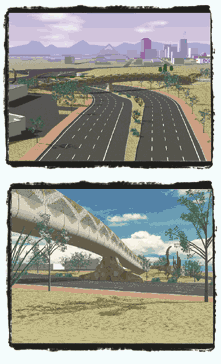 But it bothers some that he's already working on three other
public jobs, the Broadway snake, Hohokam-inspired sculptures for
the new city Community Services Building, and a rose garden gazebo
for the Tucson House. His colorful "Flying Books" went
up on Woods Library earlier this year.
But it bothers some that he's already working on three other
public jobs, the Broadway snake, Hohokam-inspired sculptures for
the new city Community Services Building, and a rose garden gazebo
for the Tucson House. His colorful "Flying Books" went
up on Woods Library earlier this year.
The way Donovan sees it, he's worked hard to perfect what he
does.
"Once you get your foot in the door, it makes all the difference,
but to set your foot in you have to have a good idea."
It's no secret that the selection juries are comforted by an
artist's prior experience. Donovan, a painter, had long worked
on other projects to make money, designing textiles and crafting
gates on private commission. To get his first public commission,
"Flying Books," he was able to show slides of his metal
gates, and now he can show slides of the colorful metal books
pinned to the library's walls.
Grygutis says other cities do set limits and suggests Tucson
could restrict artists to two active commissions in a single time
period. "If one artist gets four or five jobs in a row, artists
will be too timid to apply. If you don't (restrict) you get too
much of one aesthetic."
Hoyt Johnson is hearing the complaints. Last week he told TPAC's
public art committee that Donovan's many commissions "say
two things: he's a pretty interesting artist, and we've got a
lot of programs coming up and he's applied for them." And
he noted that two first-timers had just won roadway commissions.
Still, he's concerned enough about the issue that he has asked
the committee to re-visit the idea of limiting commissions.
Hardly any artists support the idea of restricting jobs to locals,
especially since many have gone on to make successful careers
in other cities. Gamble and Ned Gray just installed one of their
works in Boston, while Grygutis is working in San Diego and elsewhere.
Donovan is hoping his snake will be a springboard to big out-of-town
commissions. But they do disagree over exactly who an artist is.
Right now TPAC leaves the term undefined, and architects, landscape
architects and even a psychologist have snapped the commissions
up.
"These funds should not be spent for architects," Grygutis
says. "The real idea is to bring diversity to the team. Artists
provide a different viewpoint. When you put an architect in there
you lose diversity."
Architect Vint, not surprisingly, disagrees.
"Architects are doing art, artists are doing architecture.
I like the fact that the distinction between the two is fading.
It's healthy for the disciplines to come together."
HAS THE one-percent-for-art program done the city any good?
Steve Farley hopes his photographic mural will be a welcome jolt
to downtown. Filling it up with people of long-ago, he says, "I'm
going for a type of public art that says this is what the downtown
once was, what it could be."
Gary Mackender's tile mural on I-10 at Miracle Mile cheerfully
heralds the entrance to the city, but much of our public art is
hidden away, far from the daily rounds of Tucsonans. In 1994,
Melody Peters and Cristina Cardenas lovingly assembled a colored
tile mural in the heroic tradition of the great Mexican muralists.
It's full of idealized workers and diligent farmers and loving
mothers. But it's held prisoner 20 feet behind chain link and
barbed wire on the walls of the Pima County Jail at Mission Road
and Silverlake. A stern sign in red and white on the fence warns
visitors to stay at least 20 feet distant. A visiting art lover
thus must squint at it from a distance of 40 feet, through chain
link.
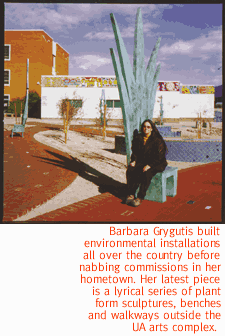 Tanz wryly notes that the mural's setting forces the viewer "to
peer in, the way people in the prison peer out. It's an accidental
commentary."
Tanz wryly notes that the mural's setting forces the viewer "to
peer in, the way people in the prison peer out. It's an accidental
commentary."
Other pieces provide accidental encounters. Tucsonans who get
out of their cars once in a while, and run and bicycle and speed-skate
along the linear river parks, are about the only ones who get
to see much of the river collection. Gamble's Santa Cruz tiles
are accessible by car from Riverside Drive, but Grygutis has four
sculpture plazas tucked along the river's pedestrian pathways.
The northernmost one is a green-tiled arch facing west over the
empty riverbed, beautifully framing Tumamoc Hill. Its curves allude
to the region's Spanish architecture; its blues and greens honor
the river that once was, and the prickly pear cactus growing out
of the top provides a real-life counterpart to a tile tree embedded
in the concrete floor.
The piece is strangely located, just south of Speedway, a stone's
throw from the noisy on-ramp for I-10. Yet on a bright-blue winter's
day last week, one person was clearly enjoying this conscientious
piece, its plaza and its gorgeous view. A homeless man on a picnic
bench presided over the place, grandly partaking of the art that
belongs to him and every other member of the public.
Fin Spin
Anatomy Of A Public Art Debacle.
THE PROTEST OVER John T. Young's "Swords into Plowshares,"
the "fins" art proposed for Tucson's Silverlake Road,
made a perfect news story.
It had no end of juicy elements: class conflict with a subtext
of racial politics; the squandering of public money; the knuckle-headed
pretensions of contemporary art. And perhaps best of all, the
chance for headline writers to indulge in a host of puns. "A
farewell to arms" and "Residents sink art made from
submarine parts," screamed the papers. The local media, including
this newspaper, jumped right in and played the story by rote.
The "people" had risen up to the defy the elite art
establishment. Drawing on their salt-of-the-earth wisdom, they
had summoned the courage to denounce the elite's pointy-headed
plan to put decommissioned submarine fins in their neighborhood.
Great story, no doubt about it, except that it might not be true.
"The people from the neighborhood loved it," said Jim
Seidman, president until this month of A Mountain Neighborhood
Association. "We need a bold statement."
Nina Borgia-Aberle, an artist on the selection panel, echoed
Seidman, "The people representing the neighborhood who were
there were in full support of it."
Some critics see the fins saga as the opposite of the media's
populist fable. This version has powerful politicians overturning
a democratic process, justifying their actions by invoking "a
people" who are never named. It was politicians who "shot
down the proposal," Seidman said. "The city manager
stepped in and said no."
Ned Gray, an artist who sat on the selection panel, agrees.
"The process was subverted. Every effort was made to include
the community...We have one person who walks in and subverts the
process and tells us we're all wrong."
City Manager Luis Gutierrez quashed the project, citing "numerous
comments of concern" and "insensitiv(ity) to the history
and culture of this particular area," in an August 5 letter
to the Tucson Pima Arts Council. At that point, the selection
panel had already been at work on the project for almost a year.
Gutierrez softened the blow by offering to find another home for
"Swords into Plowshares," while calling for new art
for Silverlake, which the city transportation department is widening.
TPAC's public art committee grumbled about the Gutierrez veto
at its September meeting, with member Stan Kryzyanowski complaining
that "12 or 13 people are dictating to Tucson." But
mindful of the precarious political standing of public art, the
members voted to go along.
WHAT WENT WRONG? Silverlake Road is a degraded streetscape of auto wreckers,
gravel pits, jails and a few scattered trailers and houses. South
of A Mountain and west of the Santa Cruz, it's a strip whose history
and culture have heretofore escaped the notice of politicians.
Following the dictates of the city's own public art policy, Hoyt
Johnson a year ago appointed a diverse panel of unpaid volunteers
to pick the art that would go along the widened roadway. The panelists
consisted of two neighborhood residents, two artists, a Latina
art teacher from Sunnyside High School, and two city staffers
from the transportation department. Transportation is exempt from
the one-percent-for-art rule, but it complies voluntarily, and
issued an open-ended call for art along the roadway. The budget--$60,000--was
big enough to attract 35 proposals, an atypically large number.
The selection process, said Albert Elias, one of the transportation
staffers "was quite routine." The panel put in a long
year of unpaid work in the trenches of democracy, sifting through
the art proposals, presenting and questioning and discussing competing
ideas in any number of public neighborhood meetings. Neighbors
within a two-mile radius were invited to the forums by fliers
mailed to their homes; the fliers were written in English and
Spanish.
Two local art teams were among the three finalists; Young, the
winner, is a Seattle artist of some repute. Made of 1960s sub
parts contributed by the U.S. Navy, his "Swords to Plowshares"
is intended as an international monument to peace and, conversely,
as a memorial to the submariners of the Cold War. Evoking the
sea, the giant fins--some 12 feet tall--will be installed only
along waterways. His first fins installation was dedicated along
a Seattle lake on Memorial Day; another is underway on a Pacific
bluff in Los Angeles. Negotiations are proceeding for a Russian
location, Young said by telephone from Seattle, where he's an
art professor at the University of Washington.
Rundown Silverlake may be, but it's near Tucson's designated
birthplace at the foot of A Mountain, and some panelists worried
that the fins didn't adequately represent Tucson's history. Young
believes they do.
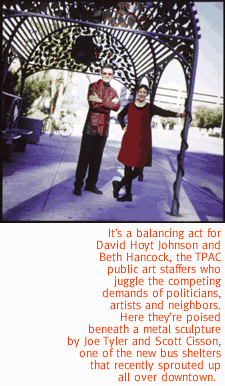 "It's about the fact that Tucson once was under an ocean,"
he said. "Fish were swimming around Tucson before there were
any people. It's about pre-human history...(it) creates this sense
of geologic history. The beauty of the site is it's on a river
wash."
"It's about the fact that Tucson once was under an ocean,"
he said. "Fish were swimming around Tucson before there were
any people. It's about pre-human history...(it) creates this sense
of geologic history. The beauty of the site is it's on a river
wash."
Nevertheless, the panel was split, 4-3, over Young's plan. A
divided vote is unusual; Transportation got nervous and asked
TPAC to do a presentation for a couple of groups charged with
overseeing the Santa Cruz. When the Santa Cruz River Commission
unanimously voiced its displeasure with "Swords," TPAC's
board decided to bring Young back to town August 3 to do another
public presentation for the neighbors.
At that point, the loudest voices raised against Young's project
were those of José Ibarra, Ward 1 Councilman, and Lillian
Lopez-Grant, powerful president of Menlo Park Neighborhood Association
and an outspoken member of the Santa Cruz River Commission. An
Ibarra staffer said at the August 3 meeting that Ibarra's Hispanic
constituents considered the fins to be militaristic, despite the
artist's intended message of pacifism.
What troubles participants is that the residents who were said
to hate Young's art didn't come to the meetings and say so.
"The 'silent' people were not there," said Seidman.
Hoyt Johnson remembers that at the August 3 meeting, "We
got no expressions of objections to the artist's proposal with
one exception. Ibarra's aide said they had been contacted."
And the number of these unnamed and invisible dissidents kept
shifting. Young remembers the staffer speaking of 100 opponents,
which he said would be "unusual" in a public art debate.
TPAC public art representative Jane Kroesen reported to her colleagues
that the staffer told her there were 12 or 13 complainants. Ibarra
himself told the Tucson Weekly he received some 24 messages
on his voice mail.
Ibarra said he's the one who brought the residents' objections
to Gutierrez.
"The voices of the neighborhood kept being pushed off,"
Ibarra said last week. "The reality was if they (the panelists)
would have been listening beforehand they could have seen that
the neighborhood wanted something else."
Two days after the meeting where only a politician's aide publicly
opposed the project, Gutierrez canceled it.
Gutierrez did not return phone calls seeking comment.
Lopez-Grant last week once again denounced the fins as "recycled
junk that's offensive" and slammed the selection process,
saying it intimidates neighborhood residents.
"The problem is the process established by TPAC," Lopez-Grant
said. "The neighborhood residents were outnumbered and intimidated.
People don't want to be made to feel dumb or uncultured so they
go along."
But participants say neither Lopez-Grant nor Ibarra attended
the meetings that they allege were flawed. And those who did attend
deny that anybody was coerced.
"I didn't see any intimidation at all," said Elias,
the city transportation planner.
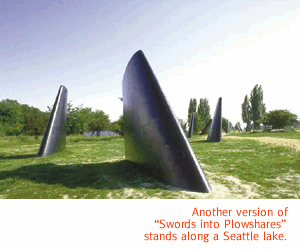 "In every single panel I've been on there's been no intimidation,"
said artist Borgia-Aberle. "To say that artists intimidated
anyone is absurd. Everyone was respectful and interested in each
other's opinions. People work in clichés to get what they
want."
"In every single panel I've been on there's been no intimidation,"
said artist Borgia-Aberle. "To say that artists intimidated
anyone is absurd. Everyone was respectful and interested in each
other's opinions. People work in clichés to get what they
want."
Lopez-Grant lives in Menlo Park on the other side of A Mountain,
but she defends her interest in Silverlake by saying that the
westside neighborhoods stick together. Seidman doesn't see it
that way.
"Lillian sticks her nose in everybody's business,"
Seidman said. "She feels proprietary about the entire Santa
Cruz River."
And it angers those who did the gut work of slogging through
meetings that those who didn't bother to come were successful
in overturning a legitimate vote.
"If you didn't go to the meetings, why are you suddenly
complaining that you don't like what was picked?" asked Seidman
with exasperation.
Added Borgia-Aberle, "I'd encourage José to get the
people out there to become more involved in the process. You have
to give up the time and energy."
WHAT'S NEXT for the fins? Fourteen neighborhoods have registered
an interest in having them, said Hoyt Johnson, and he has high
hopes for a site along the Pantano Wash. A TPAC committee has
scheduled a meeting in next month to solicit input from neighbors
for a new Silverlake proposal, pointedly inviting residents of
Silverlake and their immediate neighbors on Cottonwood and Santa
Cruz lanes. The new group will keep in mind Gutierrez's new mandate
to incorporate history, culture and tradition into every public
art project in and near downtown.
Lopez-Grant said the Westside Coalition is planning to tackle
the public art problem in the new year, partly by seceding from
the city's process while still using public money.
"I want our people to choose it. We want to be in control
of artwork in our neighborhoods. I don't care who the experts
are. We're the ones who have to live with it. It belongs to us...We
would form our own selection committee. We have our own artists
and we can use them."
And Seidman sighed about the art his neighborhood will get in
the end.
"When you choose an artist through the percent for art,
it's going to be run of the mill. It won't be anything out of
the ordinary, or make a bold statement. Politicians don't want
that controversy...I think the artist got screwed. It was a really
good project."

|





